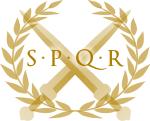Legio IV Scythica

Legio quarta Scythica ("Scythian Fourth Legion") was a legion of the Imperial Roman army founded c. 42 BC by the general Mark Antony, for his campaign against the Parthian Empire, hence its other cognomen, Parthica. The legion was still active in Syria in the early 5th century.
Origin During The Republic
In its first years, the whereabouts of IV Scythica are uncertain, although it is probable that it took part in Antony's campaign against the Parthians. The name suggests that it fought against the Scythians.
Under The Empire
After the battle of Actium and Antony's suicide, Octavian transferred IV Scythica to the Danube province of Moesia. The legion is reported to have taken part in civilian tasks, such as the building and keeping of roads. In his youth, future emperor Vespasian served in this legion.
Roman–Parthian War of 58–63
King Vologases I of Parthia invaded Armenia, a client kingdom of Rome, in 58. Nero ordered Gnaeus Domitius Corbulo, the new legate of Cappadocia, to manage the matter. Corbulo brought IIII Scythica from Moesia, and with III Gallica and VI Ferrata defeated the Parthians, restoring Tigranes VI on Armenian throne. In 62, IIII Scythica and XII Fulminata, commanded by the new legate of Cappadocia, Lucius Caesennius Paetus, were defeated by the Parthians at the Battle of Rhandeia and forced to surrender. The legions were covered with shame and removed from the war theatre to Zeugma. This city would be the base camp of IIII Scythica for the next century.
Year of the Four Emperors
In 69, the legion, like the rest of the Eastern army, sided with Vespasian immediately. Despite the demonstrated loyalty, IV Scythica was not involved in actual fighting because it was not considered a high quality legion. This has to do with another defeat years earlier in the Jewish rebellion.
Suppressing Jewish Rebellions
In the 2nd century, it participated in the suppression of another Jewish rebellion, this time with more success.
Roman–Parthian War of 161–166
It took part in the war against the Parthians between 161-166
Between AD181 and AD183 the commander of the Eastern legions was Septimius Severus, who become emperor relying on the power of his legions.
Septimius Parthian Campaign
The Legions former commander now Emperor, led another campaign against the Parthians.
Revolting and Disappears
The legion disappears from the sources after AD219, when their commander, Gellius Maximus, rebelled against Emperor Elagabalus and proclaimed himself emperor, but was defeated by Elagabalus.
However, according to Notitia Dignitatum, in the early 5th century, IIII Scythica was still in Syria, camped in Sura.
Generals, Tribunes, and More
Quintus Varius Nepos was a military tribune for Legio IV Scythica at one point.
Epigraphic inscriptions
- - Caio Sempronio Marci filio Galeria (tribu) Fido Calagorritano / tribuno militum legionis IIII Scythicae tribuno militum (...). Tarragona (Tarraco), Spain. CIL II 4427 .
- - D(is) M(anibus) / Ael(ius) Verecundinus |(centurio) leg(ionis) IIII / Scy(thicae) hastatus (p)rior natus / in Dacia ad Vatabos mil(itavit) ann(os) XXI / primum exactus librarius / frum(entarius) speculator evocatus |(centurio) et |(centurio) frum(entarius) / vixit ann(os) XXXVI Ael(ius) Rufinus lib(ertus) ex bon/is eius fecit. Epigraphic Database Heidelberg HD053009.
Unit Symbol
The legion's symbol was a capricorn.[1]
In Popular Culture
The Legion appeared in Harry Sidebottom's historical fiction series Warrior Of Rome.
See also
References
- ↑ Legions and Veterans: Roman Army Papers 1971-2000 By L. J. F. Keppie page 128
External links

